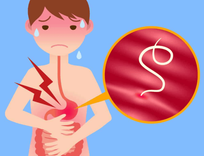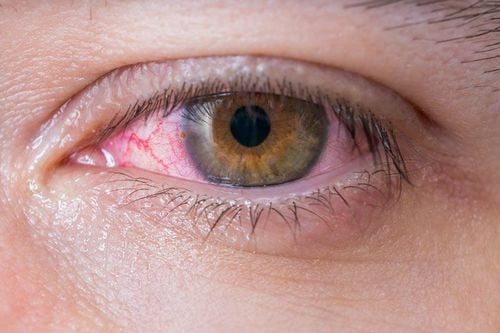Newborns and young children have underdeveloped immune systems, making them susceptible to infections, including persistent eye discharge. If your baby has eye discharge, redness, swelling, or tearing, don't hesitate to consult a doctor, as these could be signs of an eye infection.
1. What is Green Eye Discharge in Babies?
Newborns typically have healthy eyes and can perceive nearby light. Their vision gradually improves from the initial 25cm range at birth. Parents can identify early signs of eye problems, such as excessive tearing, unequal eye movements, or white pupils. Green eye discharge is a common occurrence in newborns, often leaving parents unsure whether it's a normal physiological response or a sign of something more serious.
Eye discharge, also known as eye gunk or sleep crust, is a secretion that forms while your baby sleeps. It helps prevent tears from evaporating and keeps the eyes moist. If this secretion isn't produced, it can lead to dry eyes. However, persistent eye discharge is abnormal and may indicate an eye infection.
2. What Causes Green Eye Discharge in Babies?
2.1. Conjunctivitis (Pink Eye)
Many factors can cause conjunctivitis in children, the most common being bacterial or viral infections.
- Bacterial Conjunctivitis: Common causes include Neisseria Gonorrhoeae, Staphylococcus aureus, and Chlamydia (which causes inclusion conjunctivitis). A typical sign is thick, green or yellowish discharge, sometimes making it difficult for the baby to open their eyes in the morning. It can affect one or both eyes.
- Viral Conjunctivitis: Unlike bacterial conjunctivitis, viral conjunctivitis typically presents with watery, non-purulent discharge in both eyes. Symptoms also include excessive tearing, itching, eye pain, and redness. The child may also have a fever.
2.2. Blocked Tear Ducts
Blocked tear ducts are relatively common in newborns, affecting about 10%. This occurs when a blockage prevents tears from draining properly. Symptoms include constant tearing (even when not crying), excessive discharge, and redness. These symptoms may worsen in cold, windy, or sunny weather. The condition often resolves itself within a few months. Parents can gently massage the tear duct downwards, from the inner corner of the eye towards the nose, to help clear the blockage. However, if the discharge persists and leads to pus formation, consult a doctor for diagnosis and treatment.
2.3. Foreign Objects in the Eye
Foreign objects in the eye are a serious cause of persistent discharge. A baby's eyes are delicate and sensitive to environmental changes (bright light, wind, dust, etc.). Anything that gets into the eye, such as pet hair, sand, or eyelashes, can be dangerous if not removed promptly. Carefully examine your baby's eyes if you suspect this. Seek immediate medical attention to prevent potential damage to their vision.
2.4. Exposure to Amniotic Fluid During Birth
Green eye discharge in newborns can be caused by exposure to amniotic fluid and maternal blood during delivery. This is a common type of eye infection in newborns and usually isn't cause for serious concern.
2.5. Contamination
Contamination is a common cause of green eye discharge that's often overlooked. Dirt and bacteria on hands can enter the baby's eyes when they touch their face, or if the caregiver hasn't washed their hands properly.
2.6. Improper Hygiene
Some parents, especially first-timers, may not clean their baby's eyes correctly, either due to lack of experience or fear of hurting them. Inadequate cleaning can lead to green eye discharge, making it difficult for the baby to open their eyes upon waking. If not addressed, this can increase the risk of conjunctivitis.
3. How to Clean Your Baby's Eyes When They Have Persistent Discharge
Follow these steps to clean your baby's eyes properly:
- Wash your hands thoroughly with soap and water or hand sanitizer.
- Prepare clean gauze pads or disposable wipes. Avoid cotton balls, as fibers can get into the baby's eyes.
- Moisten the gauze pad with warm water or saline solution.
- Gently wipe the eye from the inner corner outwards in a single motion, using a fresh gauze pad for each wipe.
- Clean the other eye with a separate gauze pad. Avoid wiping the eyelids directly.
- Repeat this process 2-3 times a day or whenever discharge appears.
In conclusion, newborns and young children are vulnerable to infections, including persistent eye discharge. If your baby has eye discharge, redness, swelling, or tearing, consult a doctor immediately, as these could indicate an eye infection.
To schedule an appointment, please call our HOTLINE or book online HERE. Download the MyVinmec app to manage, track, and schedule appointments anytime, anywhere.








